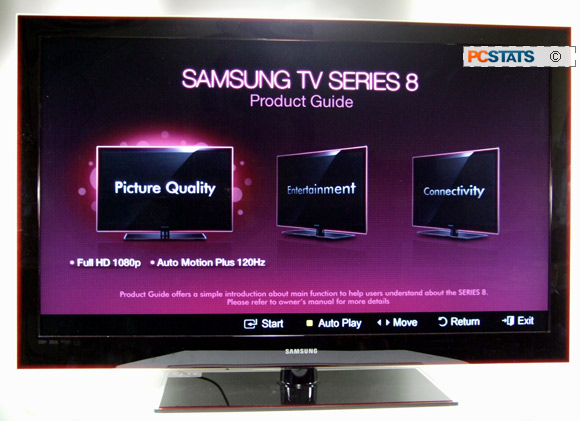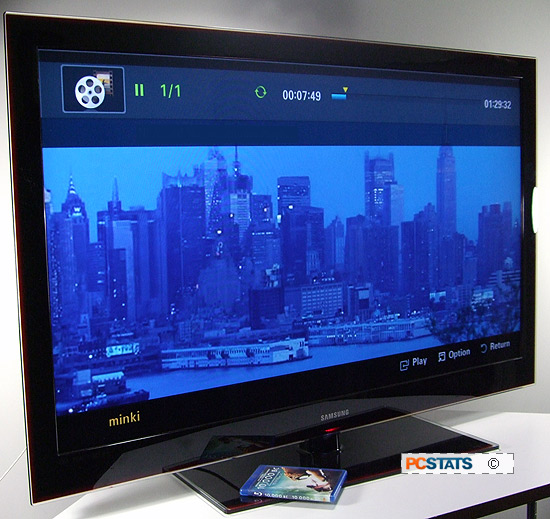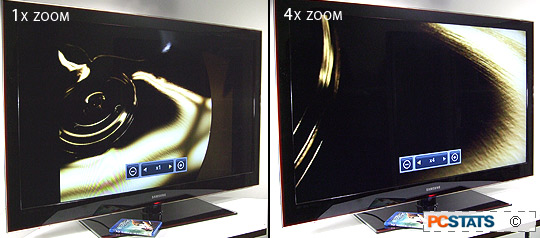How does watching video on a 52" LCD HDTV display
compare to watching it on a 40" display? Well for starters, it's important to
remember just how much more screen that extra 12" diagonal actually translates
into: the Samsung LN52A850S1F is 1170 square inches to the LN40A650A1F's 682 square inches, making the new
TV 58% larger than its little brother.

When playing back Blu-ray movies, this Samsung A850-series
display looked superb. High-definition movies showed off the fine details that
would have been lost on smaller televisions. The colour saturation and overall
dynamic contrast range of the screen made for a very vivid viewing experience,
with deep blacks and rich tones that really showed off Samsung's ability to
make LCD displays. Watching HDTV signals was similarly impressive, with over the
air ATSC broadcasts looking crisp and clear on the 52" screen.

Playing Crysis on the 52" Samsung
display at 1080p resolution feels like the game is rendered at life
size. It's like being 'in the game'!
The 52" LCD screen makes it easier to do computer tasks
like surfing the web. Regular size text was clearly visible on the LN52A850S1F
from about ten feet away, and didn't require any resizing or rescaling in order
to display correctly. Since both displays have resolutions of 1920 x 1080
pixels, the 52" Samsung display necessarily has to have a higher dot pitch than the
40", but in practice both are still more than fine enough that the
eye can't tell the difference as long as the viewer is comfortable distance
(four or more feet) away from the television.
With LCD viewing
angles set at 178/178 degrees, looking at the display from extreme angles and
viewpoints didn't affect brightness or cause any kind of colour polarization, so
putting this LCD high-definition television in a room that has couches or chairs
that aren't directly facing the LN52A850S1F will still work well.

The PCSTATS offices get quite a bit of sunlight during
the day, and with the sun shining into the room the TV still looked fine.
It's possible to use a couple of built-in
screen profiles depending on what media is being played back on the LN52A850S1F.
Scene modes include movie, game, and sports, but in practice game mode is
too contrasted and tends to eliminate midtones, and sports mode tints everything
with an unpleasant turquoise colour. For the most part the image quality
is best in movie mode, which is good for high-contrast scenes, or just leaving
the Samsung LN52A850S1F in default mode.
Does 120Hz 'Auto Motion Plus' Help or
Hinder?
While HDTV broadcasts and media have a maximum quality
of 1080p (which is to say, 1920 horizontal rows of pixels by 1080 vertical
columns of pixels refreshed 60 times per second), the Samsung LN52A850S1F HDTV
can take it a step further and perform motion interpolation,
increasing the refresh rate to an effective 120Hz. Since this is a
hardware-level implementation, the LN52A850S1F can even perform this interpolation
on sources that are presented at lower refresh rates, smoothing them out. This
feature can reduce the tearing effects in PC and console video games.
PCSTATS had time to take a closer look at Auto Motion
Plus with the Samsung LN52A850S1F, which boasts an enhanced revision of
Samsung's 120Hz motion tweening technology. Auto Motion Plus works by taking
standard 60hz video signals and interpolating an additional frame in between
them, smoothing them out and making certain scenes, in particular horizontal and
vertical panning shots, appear more fluid. Opinion was
a little divided in the PCSTATS office as to whether Auto Motion Plus was
actually making film look better. On the one hand watching certain scenes of
10,000 BC were definitely easier to follow, in particular a vertical panning sequence that
takes place on snow-covered mountains.
Auto Motion Plus uses an algorithm
to interpolate frames that were never captured on the original source,
so certain combinations of shapes and motion can cause glitching and
graphical anomalies that definitely detract from the viewing experience. This is
most apparent in panning shots where an object is moving in a direction that's
opposite to the camerea's panning motion, and severe tearing can be seen around
the edges of the object.
